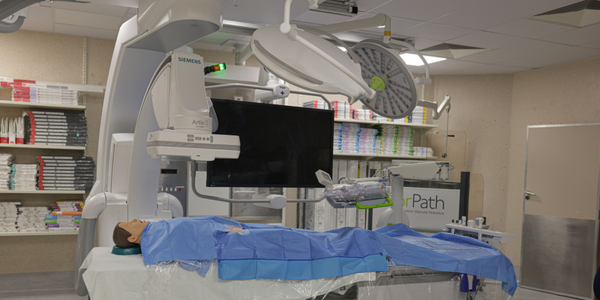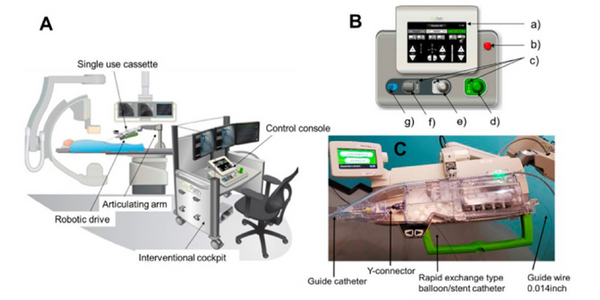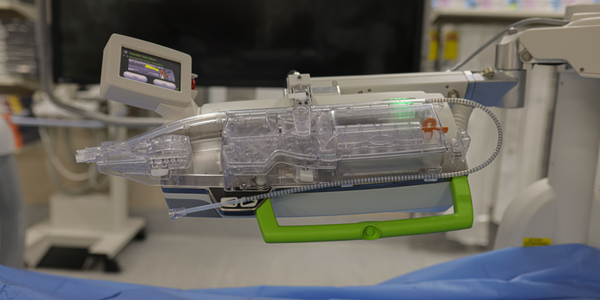Africa’s first endovascular robotic unit will advance research and enable ‘outreach intelligence’
- Wits University
The new unit at the Wits Donald Gordon Medical Centre (WDGMC) is both a robotics research opportunity and a global responsibility.

The WDGMC, the first and only private teaching hospital in South Africa, launched a state-of-the art endovascular robotics unit on 14 September 2022.
The unit is the first in Africa and the Middle East to use the Corindus CorPath GRX vascular robotic for Robotic Assisted Endovascular Interventions (RAEI).
The WDGMC trains medical experts, specialists and sub-specialists in fields including endovascular [inside the blood vessel] surgery. Endovascular surgery is a procedure that uses microscopic incisions and long, thin tubes [catheters] inserted into a blood vessel to repair it.
Professor Jay Pillai is the Academic Head of the Division of Vascular Surgery at Wits and a vascular surgeon at the WDGMC. He explains that traditional endovascular therapy is a three dimensional, active process in which wires are manipulated through the body and observed on a screen as a [mechanical] arm moves up and down.
The new robotic unit removes the interventionist from the patient, with the interventionist ‘operating’ a joystick that guides a robotic arm to conduct the surgery. An interventionist is a physician specifically trained to perform interventional or minimally invasive procedures.

Pillai says, “The issue around robotics is removing that interventionist – you take away the interventionist, remove him from theatre – and replace him with a robot. This is artificial intelligence in reactive form, but why replace the human interventionists in the first place? This is where the philosophy of endovascular robotics arises.”
Robotic philosophy
Pillai intentionally uses the word philosophy because it is the study of the knowledge of things, and the new endovascular robotic intervention refers to looking for disease in the vessel [vein] in a novel way.
“I think that philosophy is probably the right word to use when we talk about medicine, evidence and science. It governs what we do on a daily basis. But evidence-based medicine has a ladder effect, so there’s a scale to it, and robotics, I believe, is at the bottom end of that scale. I think philosophy – the study of the benefit of it, of the knowledge of it at a fundamental level – is what we should be talking about,” says Pillai.
Although vascular surgery via robotics could expedite the procedure in a repetitive and continuous manner, which may not be possible by hand, the benefit of robotics to patients, at this stage, remains questionable, he says.
Thus, it is the research that this new endovascular robotic unit has the potential to stimulate that is fundamental to its existence and its philosophy.
A global responsibility
The Corindus CorPath GRX vascular robotic now installed at the WDGM, is a product of Corindus, a Siemens Healthineers company. This product was originally designed to protect and assist interventional cardiologists in complex PCI (Percutaneous Coronary Intervention), a family of minimally invasive procedures used to open clogged coronary arteries.
Although Siemens is based in Germany, the R&D facility is in the US, where the product is used extensively for PCI. It is only in Dijon, France, and now at the WDGMC in South Africa, that endovascular applications are being explored.
“The worrying issue is that the scientific peer reviewed efforts from all of them [US centres] is almost non-existent,” says Pillai. “This shows the pressure that’s on us to provide evidence in this new stratosphere to perform this, if we can find some benefit. We’ve got to research the fundamentals of knowledge – that’s the starting point of robotics. The fact that it can be done doesn’t mean that it should be done. That’s realism. We mustn’t live a lie. It’s our duty to show that it may or may not work.”
Evidence-based research
Vascular surgeons at WDGMC, Dr Pradeep Mistry and Dr Dirk le Roux are already using the Corindus at WDGMC to advance research into patient benefits.
Mistry says they’re exploring alternative applications, or “cheats”, of the technology, given that the Corindus was originally the domain of cardiac and not endovascular interventionists. This research helps Siemens advance products for patient benefit, he says.
Dr Zoya Iqbal, Product Manager at Siemens Healthineers, says that investment in telehealth, AI and medical robotics is at an all-time high, with revenues of $25.5 billion expected by 2027. “Robotics such as Corindus brings precision medicine to the patient,” she says, but she echoes Pillai’s sentiment that “we shouldn’t just do it because we can.”
Mistry and Le Roux have used the Corindus for “a mixed bag of pathologies” based upon which one research article has been produced so far, awaiting publication. The paper explores the potential of automation to standardise patient care, and the integration of imaging with robotics.
“The problem with vascular surgery is that we need a lot of ‘pushability’. We didn’t find this system [Corindus] very friendly towards the way we practice medicine, so we had to come up with our own fixes in terms of increasing pushability,” says Mistry. “One thing we did find is that the robotic technology works in conjunction with your standard C-arm or hybrid theatre facility, and it is a good ancillary tool to use with other procedures, and not just in isolation.”

This original research enabled the WDGMC team to come up with solutions in terms of advancing the technology in the field of vascular medicine. Mistry envisages that the WDGMC Endovascular Robotics Unit will ultimately become a centre of excellence in Africa.
Applications in Africa
Aside from the global responsibility for evidence-based robotics research, Pillai suggests two potential and uniquely African applications of the Corindus: firstly, endovascular robotic surgery during a viral pandemic, and secondly, what Pillai calls ‘outreach intelligence’.
During the second peak of the 足球竞彩app排名 pandemic in August 2021, interventionists at WDGMC successfully performed endovascular robotic surgery on the world’s first 足球竞彩app排名 patient in isolation.
“This was the first Covid positive patient that was done anywhere in the world. I’m certain of it because nothing else has been published, and we’re about to do that,” says Pillai.
The intuitive benefit is not the fact that robotic surgery was done and that the patient could be treated within the blood vessel, but rather that there was nobody else in theatre.
“The transmissibility, the viral infectivity to healthcare workers is born by this new technology. 足球竞彩app排名 85% of the duration of this procedure was done without anybody in theatre,” says Pillai, but cautions that this is not “a massive scientific benefit, because it’s only one case”.
Outreach intelligence
Pillai coins the phrase ‘outreach intelligence’ to suggest how endovascular robotics can impact Africa. Outreach refers to Wits University’s capability and capacity to extend teaching, learning and clinical training to outlying hospitals. Sharing this intelligence could provide critical training, resources and support, he says.
“I don’t think anyone else in the world is looking at it from this perspective and I call it ‘outreach intelligence’. ‘Outreach’ meaning our University has this capability, and all of us participate in it and create an outreach performance to outlying hospitals, and ‘outreach intelligence’ – it comes from artificial intelligence – and there may be a benefit to it in hospitals who have limited resources, for example,” says Pillai.
Such ‘outreach intelligence’ could, for example, benefit a hospital located 30km away from WDGMC, which has a need for angiography [a type of X-ray used to check blood vessels], but has limited expertise.
“And these places actually have a demand [for such services], based on the pathology and the amount of disease that they have,” Pillai points out. “So we could have the cockpit here and the robot at another centre. This may actually not only treat a patient – a patient benefit – but create a teaching infrastructure. In other words, you can show people there how to do it.”
There are of course financial constraints implicit in this scenario, but what if the robot was a mobile unit?
“That would change things incredibly. If you look at that little thing attached to the table, it’s not impossible to create a mobile facility with a mobile technician, and you could easily get these things into various hospitals. And even if it’s just angiography, it would make a considerable difference," says Pillai. "I think this is for the future, it’s probably a public health type research project, but I think it’s something we need to start looking into."
Pillai concludes, “Robotic Assisted Endovascular Interventions [RAEI] will evolve. AI will evolve. We now have an opportunity to evolve synchronously. I think it’s at its inception, and later on when we add other features of AI, like memory, it’s going to be easier. AI will evolve into memory and from a radiology perspective, if you could feed a CT scan, for example, into a robotic machine it could memorise that and help us navigate the wires; it could choose the wires for us”, said Pillai, adding that he thinks we’re still a long way from that.”
足球竞彩app排名 the launch of the WDGMC Endovascular Robotics Unit
The launch at the Centre in Parktown, Johannesburg, kicked-off the WDGMC’s 20th anniversary celebrations, which coincide with Wits University’s centenary. In attendance at the launch were Dr Sue Tager, CEO of WDGMC; Professor Lynn Morris, Deputy Vice-Chancellor: Research and Innovation; Professor Martin Smith, Head of the Department of Surgery; Professor Hellen Myezwa, Head of the School of Therapeutic Sciences; and Arnold Basserabie, Chair of the Wits Foundation Board of Governors, amongst others. Dr Judy Dlamini, the Wits Chancellor and Chair of the WDGMC Board did the ribbon-cutting honours.
足球竞彩app排名 the Wits University Donald Gordon Medical Centre
The Wits University Donald Gordon Medical Centre (WDGMC) is a South African university hospital committed to providing best patient care as well as advancing specialist training and research. It envisages both training and retaining highly skilled medical experts in South Africa, whilst also providing highly specialised patient treatment and care. The WDGMC offers a superior training programme for specialist and sub-specialist training right here in South Africa. Through its innovative multidisciplinary approach, it seeks to establish models of care that can be replicated at a training and service level throughout the country.

